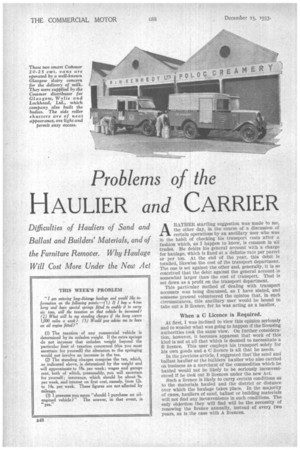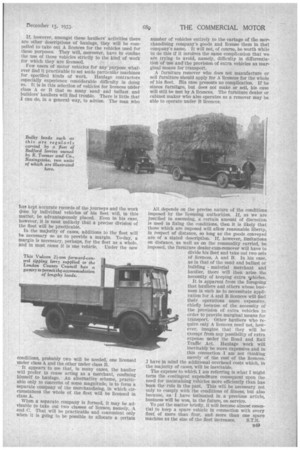Problems of the
Page 66

Page 67

If you've noticed an error in this article please click here to report it so we can fix it.
HAULIER and CARRIER
Difficulties of Hauliers of Sand and Ballast and Builders' Materials, and of the Furniture Remover. Why Haulage Will Cost More Under the New Act
ARATHER startling suggestion was made to me, the other day, in the course of a discussion of certain operations by an ancillary user who was in the habit of checking his transport costs after a fashion which, as I happen to know, is common in all trades. He debits his general account with a charge for haulage, which is fixed at a definite rate per parcel or per ton. At the end of the year, this debit is totalled, likewise the cost of the transport department. The one is set against the other and, generally, it is so contrived that the debit against the general account is somewhat larger than the cost of transport. That is set down as a profit on the transport department.
This particular Method of dealing with transport accounts was being discussed, as I have stated, and someone present volunteered the opinion that, in such circumstances, this ancillary user would •be bound to take out a B licence, for he was acting as a haulier.
When a C Licence is Required.
At first, I was inclined to view this opinion seriously and to wonder what was going to happen if the licensing authorities took the same view. On further consideration, however, it becomes apparent that work of this kind is not at all that which is deemed to necessitate a B licence. This user employs his transport solely for his own goods and a C licence is all that he needs. In the previous article, I suggested tharthe sand and ballast haulier or the builders' haulier who also carried on business as a merchant of the commodities which he hauled would not be likely to be seriously inconvenienced if he took out B licences under the new Act.
Such a licence is likely to carry certain conditions as to the materials hauled and the district or distance over which the haulage takes place. In the majority of cases, haulers of sand, ballast or building materials will not find any inconvenience in such conditions. The only objection they will find will be the necessity of renewing the licence annually, instead of every two years, as is the case with A licences.
If, however, amongst these hauliers' activities there are other descriptions of haulage, they will be compelled to take out A licences for the vehicles used for these purposes. They will, moreover, have to confine the use of those vehicles strictly to the kind of work for which they are licensed.
Few users of motor vehicles for any' purpose whatever find it practicable to set aside particuihr machines for specified kinds of work. Haulage contractors especially experience considerable difficulty in doing so. It is in this selection of vehicles for licences under class A or B that so many sand and ballast and builders' hauliers will find trouble. There is little that .I can do, in a general way, to advise. The man who
has kept accurate records of the journeys and the work gone by individual vehicles of his fleet will, in this matter, be advantageously placed. Even in his case, however, it is most unlikely that a precise division of the fleet will be practicable.
In the majority of cases, additions to the fleet will bsi necessary so as to provide a margin. To-day, a margin is necessary, perhaps, for the fleet as a whole, and in most cases it is one vehicle. Under the new conditions, probably two will be needed, one licensed under class A and the other under class B.
It appears to me that, in many cases, the haulier will prefer to cease acting as a merchant, confining himself to haulage. An alternative scheme, practicable only to concerns of some magnitude, is to form a separate company a the merchandising, in which circumstances the whole of the fleet will be licensed in class A.
When a separate company is formed, it may be advisable to take out two classes of licence, namely, A and C. That will be practicable and convenient only when it is going to be possible to allocate a certain number of vehicles entirely to the cartage of the merchandising company's goods and license them in that company's name. It will not, of course, be worth while to do this if it involves the same complication that we are trying to avoid, namely, difficulty in differentiation of use and' the provision of extra vehicles as marginal means for transport. A furniture remover who does not manufacture or sell furniture should apply for A licences for the whole of his fleet. His case presents no complication. If he stores furniture, but does not make or sell, his case will still be met by A licences. The furniture dealer or cabinet maker who also operates as a remover may be able to operate under B licences.
All depends on the precise nature of the conditions imposed by the licensing authorities. If, as we are justified in assuming, a certain amount of discretion is used in fixing the conditions, then it is likely that those which are imposed will allow reasonable liberty, in respect of distance, so long as the goods conveyed are of a stated description. If, however, limitations on distance, as well as on the commodity carried, be imposed, the furniture dealer-cum-remover will have to divide his fleet and take out two sets of licences, A and B. In his case, as in that of the sand and ballast or building material merchant and haulier, there will then arise the necessity of keeping extra voehicles. It is apparent from the foregoing that hauliers and others whose business is such as to necessitate application for A and B licences will find their operations more expensive, chiefly because of the necessity of the provision of extra vehicles in order to provide marginal means for transport. Other hauliers who require only A licences need not, however, imagine that they will be exempt from any possibility of extra expense under the Road and Rail Traffic Act. Haulage work will inevitably be more expensive and in this connection I am not thinking merely of the cost of the licences. I have in mind the additional overhead costs which, in the majority of cases, will be inevitable.
The expense to which I am referring is what I might term the contingent expenditure consequent upon the need for maintaining vehicles more efficiently than has been the rule in the past. This will be necessary not only to comply with the conditions of fitness, but also because, asI have intimated in, a previous article, business will be won, in the future, on service.
To put the matter briefly, it will become almost essential to keep a spare vehicle in connection with every fleet of more than four, and more than one spare machine as the size a the fleet increases. S.T.R.




































































































